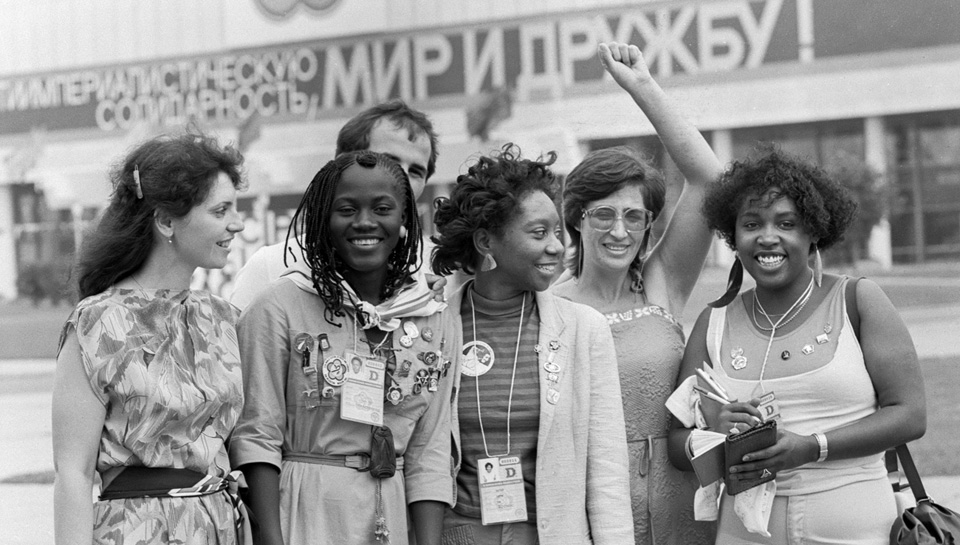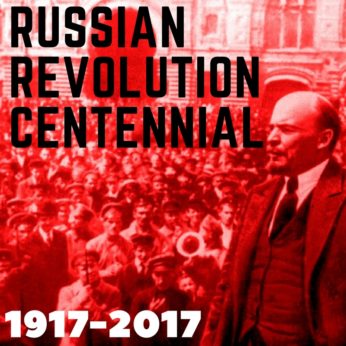
The Centennial of the Russian Revolution
November 7, 2017 marks the 100th anniversary of the Russian Revolution and the establishment of the world’s first socialist state. To commemorate the occasion, People’s World is presenting a series of articles that present wide-angled assessments of the revolution’s legacy, the Soviet Union and world communist movement which were born out of it, and the revolution’s relevance to radical politics today. Proposals for contributions are welcome and should be emailed to cjatkins@peoplesworld.org. Other articles in the series can be read here.
“Workers of all nations, unite!” 
When Marx and Engels, the founders of scientific socialism, penned those famous words, now the most beloved slogan of communists around the world, they had not done a thorough analysis of their implications for the peoples of Asia, Africa, and Latin America. Their direct contacts at the time were mostly with workers in Western Europe and the United States.
But as the major European powers, and later the U.S., scrambled to grab control of the resources and markets of the whole world, the socialist movement began to have more access to information about what was going on in far flung places such as the Congo, the Dutch East Indies, German Southwest Africa, India, South Africa, and Latin America. This was followed by direct contacts with anticolonial activists from those areas. The input of people like Ho Chi Minh from Vietnam and others injected into the world’s socialist discourse an understanding of how imperialism and colonialism reinforced capitalism, and therefore how the freedom struggles of these countries were a necessary part of the fight of workers everywhere to bring down the capitalist system and replace it with socialism.
Though some sections of the socialist movement did not comprehend the necessity of such “proletarian internationalism,” and even stuck to the idea that the prosperity of European workers depended on the continuation of colonialism, the left wing of the socialist movement took a different tack. By the time of a key socialist conference held in Stuttgart, Germany in 1908, anti-imperialist struggle was clearly emphasized, for instance in the report on the conference of the Russian Bolshevik leader, V.I. Lenin.
In 1916, Lenin wrote Imperialism: The Highest Stage of Capitalism. In this work, he showed how the capitalist system in the wealthier countries survives only by means of the exploitation of the poorer countries. Communists now agreed that you couldn’t fight for socialism and against capitalism without fighting also against imperialism, and this implied full solidarity with the people’s (and not only workers’) liberation struggles in the poor countries of Asia, Africa, and Latin America.
Proletarian internationalism
The stance of the new Soviet Union on the question of imperialism/colonialism got immediate support in the poorer countries of the world. Important contributions to Marxist and communist theory and practice began to manifest themselves in such diverse countries as “French Indochina,” India, China, South Africa, Peru (where Peruvian Communist Party leader José Carlos Mariategui made a major contribution), Mexico, Brazil, and many other places. In many such countries, new communist parties, modeling themselves on Russia’s Bolsheviks, but adapting their tactics to national conditions, arose and integrated themselves into the Comintern—the Third, or Communist International.
Indeed, the requirement for any party wanting to be part of the Comintern was phrased this way:
“Parties in countries whose bourgeoisie possess colonies and oppress other nations must pursue a most well-defined and clear-cut policy in respect of colonies and oppressed nations. Any party wishing to join the Third International must ruthlessly expose the colonial machinations of the imperialists of its ‘own’ country, must support—in deed, not merely in word—every colonial liberation movement, demand the expulsion of its compatriot imperialists from the colonies, inculcate in the hearts of the workers of its own country an attitude of true brotherhood with the working population of the colonies and the oppressed nations, and conduct systematic agitation among the armed forces against all oppression of the colonial peoples.”
The convergence of “Bolshevism” with anti-colonial struggles terrified the imperialist powers, including the United States. In most poor countries where communist movements arose, they were subjected to ferocious repression. Yet the communist idea, including the notion of worldwide solidarity among all working people, kept spreading.
After the Second World War, Soviet aid to the nations of Africa, Asia, and Latin America stepped up greatly. At first, this aid was heavily concentrated in the Middle East, then in the countries of East Asia as friction between the Soviet Union and the People’s Republic of China became intense. As African countries began to gain their independence from the original colonial powers, they became a major focus for Soviet aid, and also for aid from some of the socialist countries of Central and Eastern Europe, especially Czechoslovakia, the German Democratic Republic, and Yugoslavia, as well as from China.
This development aid, though rooted in the idea of solidarity with workers’ struggles, was sometimes given almost irrespective of the political orientation of the leadership of the receiving country. For instance, there was considerable Soviet aid to Iran during the reign of Shah Mohamed Reza Pahlavi, who, at the same time as he was receiving this aid, was closely allied with the United States and was ferociously repressing Iran’s communists.
After the Cuban Revolution triumphed on January 1, 1959, when the United States stepped up its efforts to overthrow the new socialist government, Soviet and Eastern European solidarity aid to Cuba sharply increased. When, partly inspired by the Cuban Revolution, left-wing forces began to advance and in some cases (like Nicaragua) take power, they received Soviet and socialist bloc aid also.
The types of aid given included:
– Military aid, e.g. to Vietnam during the Vietnam War, and to the People’s Democratic Republic of (North) Korea during the Korean War, as well as to Cuba to defend itself against U.S. threats, and to the Cuban forces fighting against the apartheid regime and its allies in Southern Africa. Piero Gleijeses wrote two excellent books that give a fascinating and detailed description of relations between the Cuban and Soviet governments in the fight against apartheid and refute the idea that Cuba simply acted as a Soviet proxy in that situation.
– Relatively favorable trade relationships, often entailing barter arrangements, through Comecon, the Council of Mutual Economic Assistance, which was founded in 1949 to coordinate trade relations among the socialist countries of Eastern Europe. In the mid-1950s, it began to greatly expand its activities in providing favorable trade relations and developmental aid to the poorer countries of Asia, Africa, and Latin America. Comecon eventually developed trade and aid agreements with over 100 countries, many of them the poor former European colonies in Africa. Though Comecon’s relations with the poorer countries were not without conflicts and disagreements, the organization was seen by many in these countries as a valuable counterweight to the “neo-colonialist” economic and political domination by the former colonial powers, the United States, and the other wealthy capitalist countries.
– Direct development aid and credit on favorable terms for the development of infrastructural projects designed to make industrialization of the recipient countries possible.
– Sending of Soviet and Eastern European personnel to recipient countries to build and sometimes help operate hydroelectric generation systems, factories, seaports, and other major infrastructural projects, with the control of these facilities eventually turned over to the local people once they had enough trained people do the job.
– Scholarships for large numbers of people from poor countries of Asia, Africa, and Latin America to come study in Soviet and Eastern European institutions. Patrice Lumumba University in Moscow hosted huge numbers of African students, many from poor families, and provided them not only with free scholarships, but also free housing and meals and even warm clothing for the Russian winter. The German Democratic Republic, Czechoslovakia, and other socialist countries also provided this kind of aid.
The leadership of the capitalist word interpreted Soviet and Eastern European solidarity aid as a “Cold War” strategy of challenging the U.S.’ “sphere of influence,” rather than a sincere effort to carry out the communist idea of “proletarian internationalist” solidarity. But the spin-off of this aid was that it created an incentive for the United States, Western Europe, and the developed capitalist world to up the ante and offer their own aid programs. And while in raw quantitative terms Western aid was sometimes more than Soviet and East European aid (such a comparison is notoriously hard to make), there were often strings attached; e.g. no money for countries with left-wing governments. Also, the USSR and socialist bloc countries were not nearly as wealthy as the United States and the Western European countries.
The end of socialism means an end to aid
After the collapse of the socialist governments in the USSR and Eastern Europe in the period 1989-91, this kind of solidarity aid was abruptly cut off. Opportunistic and reactionary politicians in the former socialist countries began to stir up racist attitudes toward African and other non-European students who were studying in their universities and training schools, just at the moment that the rug was being pulled out from under those students by the cancellation of free tuition and other financial support.

Not only did African students, who had come to Moscow or Prague with the promise of a free education, suddenly have to scramble to find ways to pay their tuition and fees, but they were now insulted as “monkeys” and sometimes physically assaulted. The result was an exodus of Africans and other students from the former socialist countries.
Once socialist bloc solidarity aid dried up, the Western capitalist powers saw no need to offer such generous help to the poorer countries of the world any longer. The rich countries would now relate to the poor countries almost entirely on the basis of the neoliberal “Washington Consensus,” either directly or indirectly through the World Bank and International Monetary Fund. Aid now often came only in the form of credit with high interest rates—credit which, moreover, was only provided if the recipient government would accept the neoliberal program of austerity, privatization, and so called “free trade.” Effectively, this meant opening up one’s economy to full penetration by major transnational corporations—things that Soviet and socialist bloc aid never required.
Cuba still upholds the cause of working class internationalist solidarity. After the collapse of the Soviet Union in 1991, Cuba found itself in dire straits, the so-called “special period.” This writer was in Havana in 1995 and witnessed the severe economic difficulty to which ordinary Cuban families were subjected by the unforeseen situation brought on by the Soviet collapse, but also the determination of the Cuban Communist leadership not to buckle to capitalism, nor to give up on what they defined as the accomplishments of the Revolution in terms of health care, schooling, housing, and social justice for all.
Cuban solidarity help to countries even poorer than itself never stopped. It continues to this day. Even though Cuba suffered damage from Hurricane Irma, it immediately offered emergency aid to other countries hit. Cuba (and Venezuela) offered help to Puerto Rico in the form of technicians to get its flattened electrical grid up and running again, among other things. The Trump administration has so far not accepted that aid.
Millions of people worldwide admire Cuba’s example, which has inspired socialist, left-wing, and progressive governments to similar efforts. The “Bolivarian” movement in Latin America, now under siege, also promotes the idea that the relationships among richer and poorer countries should be based on unstinting help by the former to the latter, without exploitative conditions like those of the “Washington Consensus.”
The idea of human solidarity is as old as humanity, but in our time, it cannot be realized fully except under socialism. Both bourgeois ideology and the institutions of capitalism stand in the way of the kind of solidarity that humanity yearns for.
Yet another reason to keep on the struggle for socialism.










